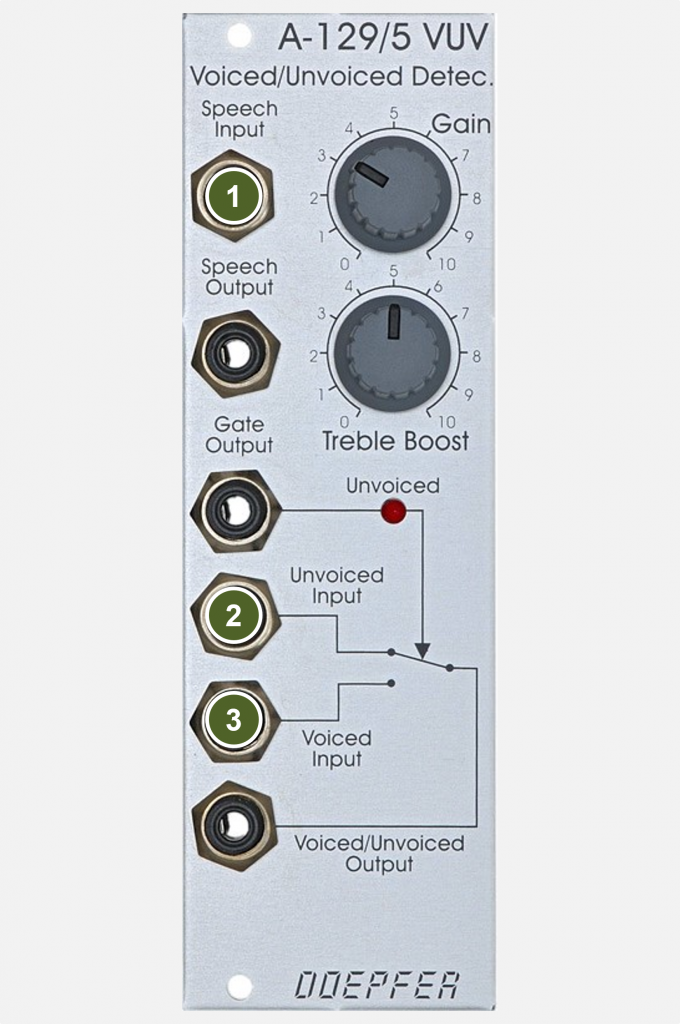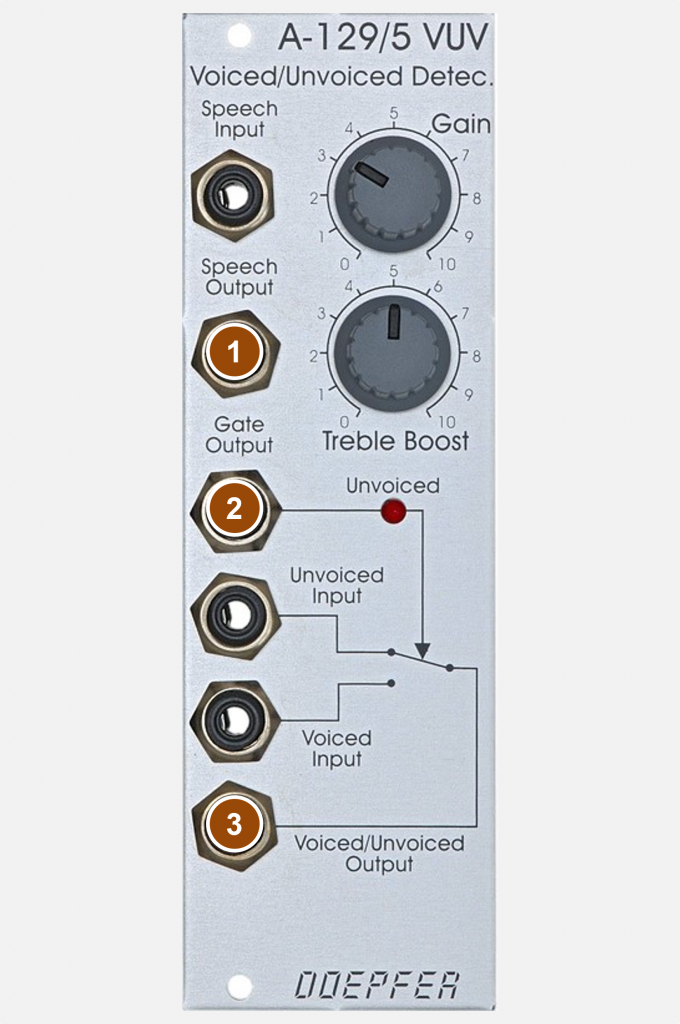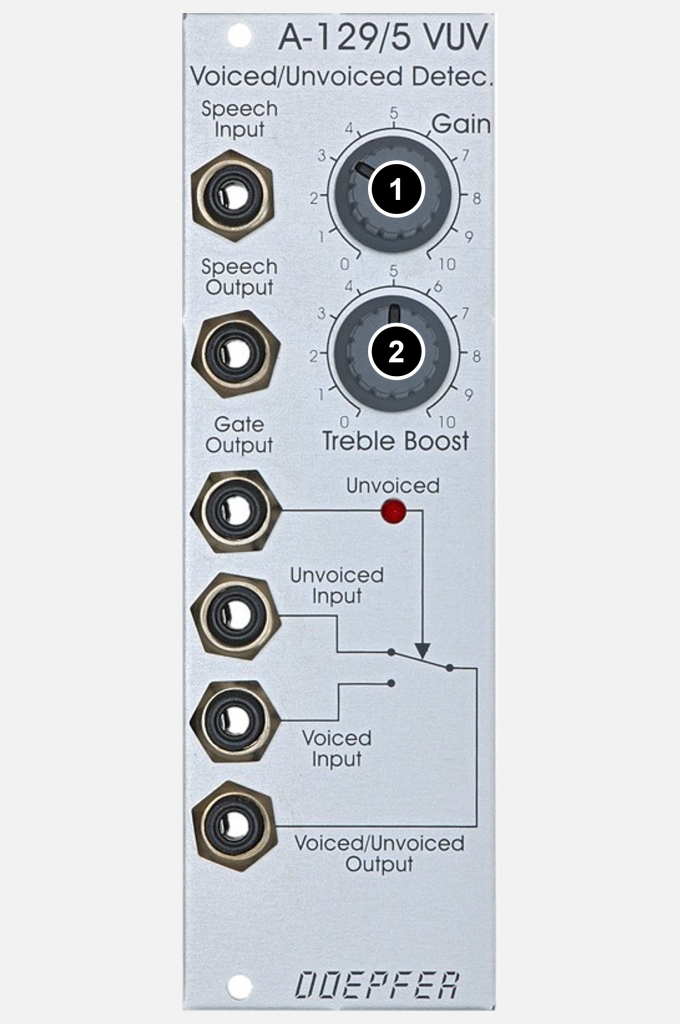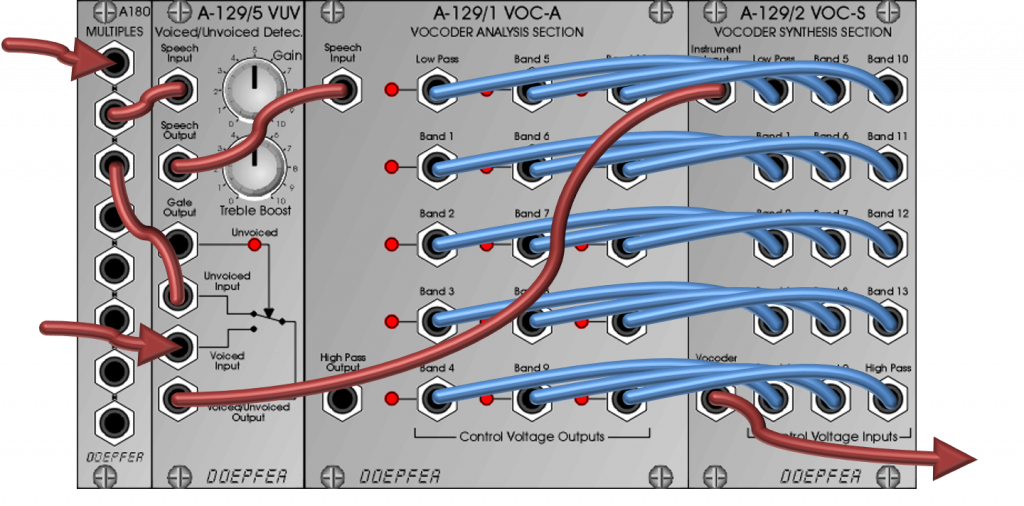The module is no longer in production.
The principle of the vocoder has problems with unvoiced modulator signals: For example, the hissing and explosive sounds when speaking (s, sh, t, p, etc.). If they are processed like vowels, the speech intelligibility of the result is usually not particularly high. That’s why vocoders often have modules that can recognize unvoiced input material and then process it differently.
The A-129 / 5 Voiced / Unvoiced Detector generates a gate signal as long as an “unvoiced” input signal (i.e. a hissing or explosive sound) is present. In addition, a 2 in 1 switch is built in, which can, for example, switch between different vocoder carrier signals (e.g. a noise generator as a carrier for unvoiced speech input and a VCO as a carrier for voiced speech input).
User interface
Inputs:

- Speech Input: Audio input for the modulator signal (in typical vocoder applications this is voice or singing).
- Unvoiced Input: Audio input for a carrier signal that is well suited for impressing “unvoiced” parts of the modulator signal (e.g. noise).
- Voiced Input: Audio input for a carrier signal that is well suited for impressing “voiced” parts of the modulator signal (e.g. a string pad sound).
Outputs:

- Speech Output: Audio output for the slightly pre-processed carrier signal from the “Speech Input” (volume and treble adjustment).
- Gate Output: Output at which a gate signal is present when an “unvoiced” modulator signal is detected, which can be used to control other modules, for example.
- Voiced / Unvoiced Output: Audio output at which either the appropriate carrier signal for “an unvoiced” modulator or the appropriate carrier signal for a “voiced” modulator is output (2 in 1 switch from the inputs “Voiced Input” and “Unvoiced Input”). Switching is controlled by identifying an “unvoiced” modulator signal at the “Speech Input”.
Controls:

- Gain: Controller for amplifying the modulator audio signal at the “Speech Input” input.
- Treble Boost: Controller for increasing the treble portion of the modulator audio signal at the “Speech Input” input.
Language processing
In order to implement different processing of voiced and unvoiced parts of speech in the vocoder, the speech is first routed to the Detector, if necessary raised a little in the treble, and from there it only reaches the module A-129 / 1 Analysis Section. The carrier signal for the voiced part of speech is connected to the “Voiced Input” and a suitable noise source (e.g. A-117) to the “Unvoiced Input” of the A-129 / 5. Finally, the “Voiced / Unvoiced Output” is filtered in the A-129 / 2 Synthesis Section.
Variations
If the switching of the different carrier signals is too hard, a smoother transition can be realized for the gate signal of the A-129 / 5 via a voltage-controlled crossfader and a slew limiter (e.g. A-171-2) instead of the internal 2 in 1 switch.
Sometimes it makes sense to use the unvoiced part of speech directly by adding it to the vocoder. To do this, the speech input signal is split up and mixed with the vocoder output using the gate and an amplifier.

Possible uses outside of the vocoder
The Voiced/Unvoiced Detector can also be used outside of the rather complex vocoder setup. For example, you can use vocals/speech as the input signal and use the gate output to trigger clicks or drums. Or – so to speak “voice-controlled” – switch between two different sound sources, such as a sequence and a noisy sound.
Sound examples
-
A-129/5 drums in vocoder with voiced/unvoiced detector
In this sound example, the basic vocoder modules A-129/1 & 2 are additionally connected to three A-129/3 vocoder slew limiters. The three A-129/3 Vocoder Slew Limiters are jointly controlled by one A-129/4 Slew Limiter Controller.
All vocoder modules are preceded by an A-129/5 Voiced/Unvoiced Detector. Its “Speech Input” is a drum sequence from the “Easy Drummer” plugin, which is also used as an “unvoiced input”: If the vocoder detects “unvoiced” parts, it switches to the original drums. “Speech Output” from the A-129/5 goes into the “Speech Input” of the A-129/1, “Vocoder Output” from the A-129/2 goes back into the “Voiced Input” of the A- 129/5 as an alternative for the unprocessed original signal of the drums in the “Unvoiced Input”.
The A-129/2’s carrier (“Instrument Input”) is colored noise from an A-118-1. Some reverb and delay, as well as compression from the DAW.
I start with minimal gain and treble boost in the A-129/5. Then I manually increase the “Gain” control (up to about 0:50) and turn it back down again. Then I increase the “Treble Boost” to 5 and then the “Gain” control again up to the maximum and back to 0 again. After this, I increase the “Treble Boost” to maximum and then the “Gain” controller to maximum as well and back again.
Technical specifications
| Width | 8 HP |
| Depth | 45 mm |
| Power requirements | 30 mA (+12V) / -20 mA (-12V) |
